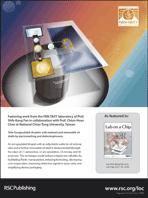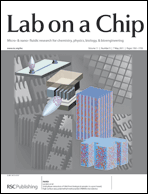 The image on the outside front cover of Issue 16 shows the method developed by Damien Baigl, Ecole Normale Superieure, Paris, and colleagues to reversibly switch from a continuous two-phase laminar flow to a droplet generating regime in microfluidic chips. They have achieved this by incorporating a photosensitive surfactant into the aqueous phase.
The image on the outside front cover of Issue 16 shows the method developed by Damien Baigl, Ecole Normale Superieure, Paris, and colleagues to reversibly switch from a continuous two-phase laminar flow to a droplet generating regime in microfluidic chips. They have achieved this by incorporating a photosensitive surfactant into the aqueous phase.
Photoreversible fragmentation of a liquid interface for micro-droplet generation by light actuation
Antoine Diguet, Hao Li, Nicolas Queyriaux, Yong Chen and Damien Baigl
Lab Chip, 2011, 11, 2666-2669
 On the inside front cover we have μFlowFISH – an integrated microfluidic device capable of performing 16S rRNA fluorescence in situ hybridization with flow cytometric detection for identifying bacteria. The device developed by Anup K. Singh, Sandia National Laboratories and colleagues at Lawrence Berkeley National Laboratories was tested in a highly contaminated site using species involved in Cr(VI) remediation and was proved capable of quantitative detection of low numbers of microbial cells from complex samples.
On the inside front cover we have μFlowFISH – an integrated microfluidic device capable of performing 16S rRNA fluorescence in situ hybridization with flow cytometric detection for identifying bacteria. The device developed by Anup K. Singh, Sandia National Laboratories and colleagues at Lawrence Berkeley National Laboratories was tested in a highly contaminated site using species involved in Cr(VI) remediation and was proved capable of quantitative detection of low numbers of microbial cells from complex samples.
Microfluidic fluorescence in situ hybridization and flow cytometry (μFlowFISH)
Peng Liu, Robert J. Meagher, Yooli K. Light, Suzan Yilmaz, Romy Chakraborty, Adam P. Arkin, Terry C. Hazen and Anup K. Singh
Lab Chip, 2011, 11, 2673-2679
View the rest of the issue, which includes the first in the series of Research Highlight articles from Ali Khademhosseini, reviewing the current literature in miniaturisation and related technologies, a Critical Review from Daniel T. Chiu on transitioning disposable microfluidic substrates from the lab into the clinic and a Focus article from Helene Andersson Svahn on massively parallel sequencing platforms.














 The image on the outside front cover depicts a microfluidic artificial photosynthesis platform created by
The image on the outside front cover depicts a microfluidic artificial photosynthesis platform created by  Highlighted on the inside front cover is another exciting article, demonstrating the 3D focussing of particles in a microfluidic channel using standing surface acoustic waves. The paper builds on previous work from
Highlighted on the inside front cover is another exciting article, demonstrating the 3D focussing of particles in a microfluidic channel using standing surface acoustic waves. The paper builds on previous work from  The striking image on the
The striking image on the  Quantitative and sensitive detection of rare mutations using droplet-based microfluidics
Quantitative and sensitive detection of rare mutations using droplet-based microfluidics
 Manipulating cells in microfluidic chips is often accomplished with a magnetically driven microtool (MMT), driven by a permanent magnet. However MMTs driven by permanent magnets suffer from low positioning accuracy and response speed. Here, Masaya Hagiwara (
Manipulating cells in microfluidic chips is often accomplished with a magnetically driven microtool (MMT), driven by a permanent magnet. However MMTs driven by permanent magnets suffer from low positioning accuracy and response speed. Here, Masaya Hagiwara (
 The prize is awarded annually to recognise an exemplary published paper for its impact on advancing science and technology in areas relevant to Corning’s strategic focus and expanding commercial opportunities for Corning.
The prize is awarded annually to recognise an exemplary published paper for its impact on advancing science and technology in areas relevant to Corning’s strategic focus and expanding commercial opportunities for Corning.

 Another great issue of LOC is now available online, including Paul Vulto et al.‘s HOT article describing their new phaseguide technology for filling and emptying of microfluidic structures, independent of the chamber and channel geometry, which is highlighted on the
Another great issue of LOC is now available online, including Paul Vulto et al.‘s HOT article describing their new phaseguide technology for filling and emptying of microfluidic structures, independent of the chamber and channel geometry, which is highlighted on the  On the
On the